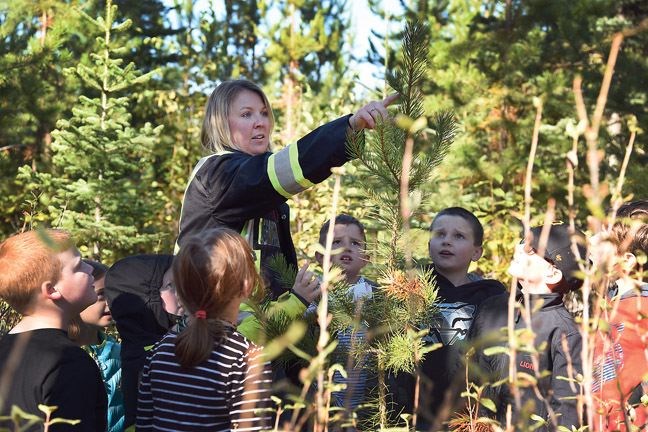Within seconds on the trail, dense forest surrounds nine children scampering uphill behind their new tour guide teachers.
Sunlight streaks through, catching upturned faces and later an open spot on the forest floor.
Even that's a lesson.
While the light catches low-growing plant life, a few steps away thin trees stand in shadows.
"Look on the ground. Do you see any other types of plants growing over there?" asks Jesse Anaka to a chorus of "no's" from the kids.
"That's because there's more sun reaching the forest floor," says Anaka, who had a dual role on Thursday's class trip as biologist and father.
"They're all fighting for the sun and the water and the nutrients in the soil," forestry technician Christine Taylor explains.
"They're all about 50 years old but they're all really little."
Through the hour-long walk along the Willow River Interpretive Trail the Grade 3 students, pulled from Hart Highlands and Heather Park elementaries, chatter away asking questions and interrupting explanations about the working woodlot.
Their guides stop at predetermined points, but just as often the kids find some fascinating discovery and want to know more.
They learn about tree spacing trials, how to spot Redosier Dogwood and where moose might have nibbled at the edges. They learn how to count the age of young pine trees by branches and then by rings later in life.
They learn what an ecosystem looks like and watch nurse logs in action.
"That looks like a tree," says Ben Lund, leaning his freckled face close to the fallen log where there is a tiny growth, then grinning as Taylor agrees with his assessment.
He guesses it's a spruce, but Taylor tells him it could be Balsam, which also stretches high above the boy's red head.
Getting outside the classroom offers a different way of learning and a space for some kids to show off an uncommon expertise.
"There are definitely kids who don't get the opportunity to call out the right answer in classroom but they are doing it out here," said Christen Hofferd, a Heather Park elementary teacher.
Then there's the girl - one of the quietest in class - who chatters non-stop, pointing out mushrooms and berries and leaves.
"It might not be what's on topic, but she's gaining a sense of comfort and independence and she's (coming) out of her shell a little bit so maybe that will open up opportunities for her to go outside her comfort zone inside of the classroom as well," Hofferd said
The outdoor approach offers one more building block, where Anako hopes children can start seeing the bigger picture.
"I think it's important for them to find a connection, empathy with nature and have a sensitivity towards what's around them so the next time they go for a walk, it's not just walking down a trail it's looking up and maybe having a connection with a tree they understand more or a sound they hear," he said.
Lund, who read from the signs and barely stumbled over scientific words, said he learned from his grandpa, a former mill worker who once fought a forest fire.
That fun fact came up often as Lund offered his observations.
He loves being in nature and said his favourite part Thursday was learning from the nice guides.
"It feels like the tour guides are saying 'Hey when you grow up you want to be one of us,'" Lund says.
That's the gist of what walk coordinator Anna Monetta hoped some would take away.
All week the Cariboo Section of the Canadian Institute of Forestry has offered several daily sessions.
Willow River has a working woodlot like a working forest, she said, where children can see examples of forest management.
It sponsors the tours for Grade 3 and 6 students.
"People are retiring and we need replacements," said Monetta.
Mid-week she already had more than 80 signed up for the final walk on Saturday and more than a dozen on the waitlist.
"Prince George is a forestry-based city so it's a good opportunity to get the kids out there."


